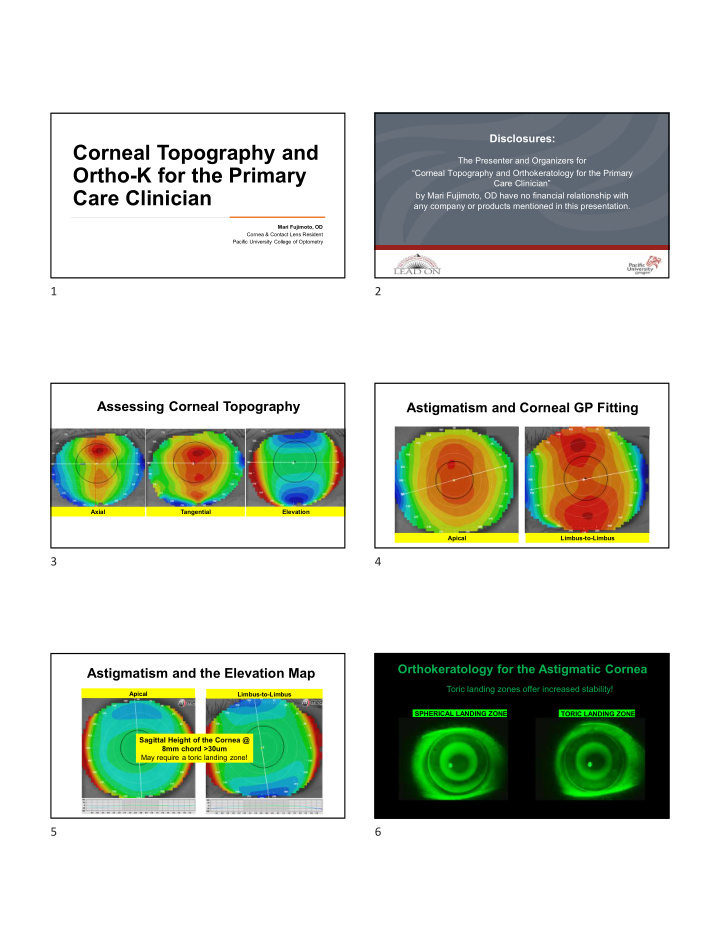



Disclosures: Corneal Topography and The Presenter and Organizers for Ortho-K for the Primary “Corneal Topography and Orthokeratology for the Primary Care Clinician” Care Clinician by Mari Fujimoto, OD have no financial relationship with any company or products mentioned in this presentation. Mari Fujimoto, OD Cornea & Contact Lens Resident Pacific University College of Optometry 1 2 Assessing Corneal Topography Astigmatism and Corneal GP Fitting Axial Tangential Elevation Apical Limbus-to-Limbus 3 4 Orthokeratology for the Astigmatic Cornea Astigmatism and the Elevation Map Toric landing zones offer increased stability! Apical Limbus-to-Limbus SPHERICAL LANDING ZONE TORIC LANDING ZONE Sagittal Height of the Cornea @ 8mm chord >30um May require a toric landing zone! 5 6
How does Ortho-K Work? Orthokeratology POSITIVE PUSH FORCE • Overnight GP lens wear reshapes NEGATIVE PULL FORCE NEGATIVE PULL FORCE the corneal epithelium to provide optimal foveal correction and a ring of midperipheral add • CRT is FDA-approved for use in myopia up to 6.00D and WTR astigmatism up to 1.75D • VST is FDA-approved for use in myopia up to -5.00D and WTR astigmatism up to 1.50D 7 8 Initial Fitting and Clinical Assessment for Orthokeratology 1. Accurate manifest refraction Case 1 2. Consider the patient’s age, refractive error, daily activities 3. Collect high quality topography scans 9 10 16 YO Male Football Player Composite Axial Maps OD/OS • CC: “I have glasses, but I cannot wear them in my helmet. A lot OD Sag differential @ 8mm: 30 microns OS Sag differential @ 8mm: 33 microns of our games are around 5PM and it gets a little tough to see the football.” Right Eye Left Eye 20/100-2 PH 20/20 sc VA 20/100 PH 20/20- -1.50-0.50x180 20/20 Refraction -1.50-0.25x005 20/20 42.60 / 44.50 @ 089 K’s 42.89 / 44.69 @ 091 11 12
Ortho-K follow-up Assessing Topography: The Scale • 1-day follow-up • Ensure centered treatment zone and corneal health • 1-week follow-up • 1-month follow-up • 3-month follow-up • 6-month follow-up • Check vision, corneal health, and compare topography to baseline 13 14 Right Eye 1-Week F/U AXIAL COMPARISON MAP TANGENTIAL COMPARISON MAP Patient notices that sometimes Using the he has difficulty Comparison focusing at near. He also reports Map mild glare at nighttime. VA: 20/20- ORx: +1.00 15 16 Left Eye 1-Week F/U Centered Central Smiley Treatment Island Face What do these maps tell us about the fitting properties of the lens? VA: 20/25- Flat lens, riding Bullseye pattern, Excessive apical ORx: +1.25 what we want to clearance, high, tighten the AXIAL TANGENTIAL alignment curve on see! flatten base curve the eye 17 18
Right Eye 3-month F/U Left Eye 3-month F/U The patient reports that the correction lasts throughout the day and vision is comfortable! He is excited and ready for football season! VA: 20/15- VA: 20/15- ORx: +0.50D ORx: +0.75D 19 20 34 YO Male Post-LASIK • “My vision is not as sharp as I would like it and I am interested in other options besides glasses.” • Ocular Hx: LASIK 7 years prior to examination Case 2 Right Eye Left Eye 20/25- sc VA 20/30-2 PH 20/20 -0.50-0.25x032 Habitual Spectacle Rx -0.75-1.25x165 VA: 20/20 VA: 20/20 40.09 / 41.06 @ 104 K’s 40.11 / 41.27 @ 076 21 22 Reverse-Geometry Corneal Composite Axial Maps OD/OS GP Lens Fitting OD Sag differential @ 8mm: 39 microns OS Sag differential @ 8mm: 39 microns N T Daily Wear Ortho-K 23 24
OD 10-Day Axial Display Lens Dispense OD and OS Pre-Treatment Difference Map Patient reports glare and halos that he notices in his right eye and a little bit of imbalance when he is reading. VA: 20/20- ORx: +0.75 Post-Treatment 25 26 OD 10-Day Tangential Display OS 10-Day Axial Display Pre-Treatment Difference Map Pre-Treatment Difference Map The patient reported good and comfortable vision in his left eye, Decentration of the with the effect lasting all flattening effect and throughout the day. inferior midperipheral plus power greater than VA: 20/20 +2 superior. ORx: +0.75D Consider the pupil size! Post-Treatment Post-Treatment 27 28 Final Thoughts Sources • The corneal topography can reveal valuable information! Vanderveen D, Kraker R, et al. Use of Orthokeratology for the Prevention of Myopic Progression in Children. Opthalmol. 2019; 126: 623-636. • Axial = Power Van der Worp E, Ruston D. Orthokeratology: An Update. Optometry in • Tangential = Shape / overnight lens position Practice. 2006;7:47-60. • Elevation Kojima R, Caroline P, et al. Should all orthokeratology lenses be toric? • Understanding the parameters the lab can adjust on your ortho-k Poster presented at the 2016 GSLS , Jan. 2016, Las Vegas. lens designs may allow for more effective treatment Korzen E, Caroline P. The Anatomy of a Modern Orthokeratology Lens. • Reverse geometry lenses may allow a more optimal fit on an Contact Lens Spectrum . 2017 Mar;32:30-32,34,35,40. oblate cornea 29 30
Recommend
More recommend